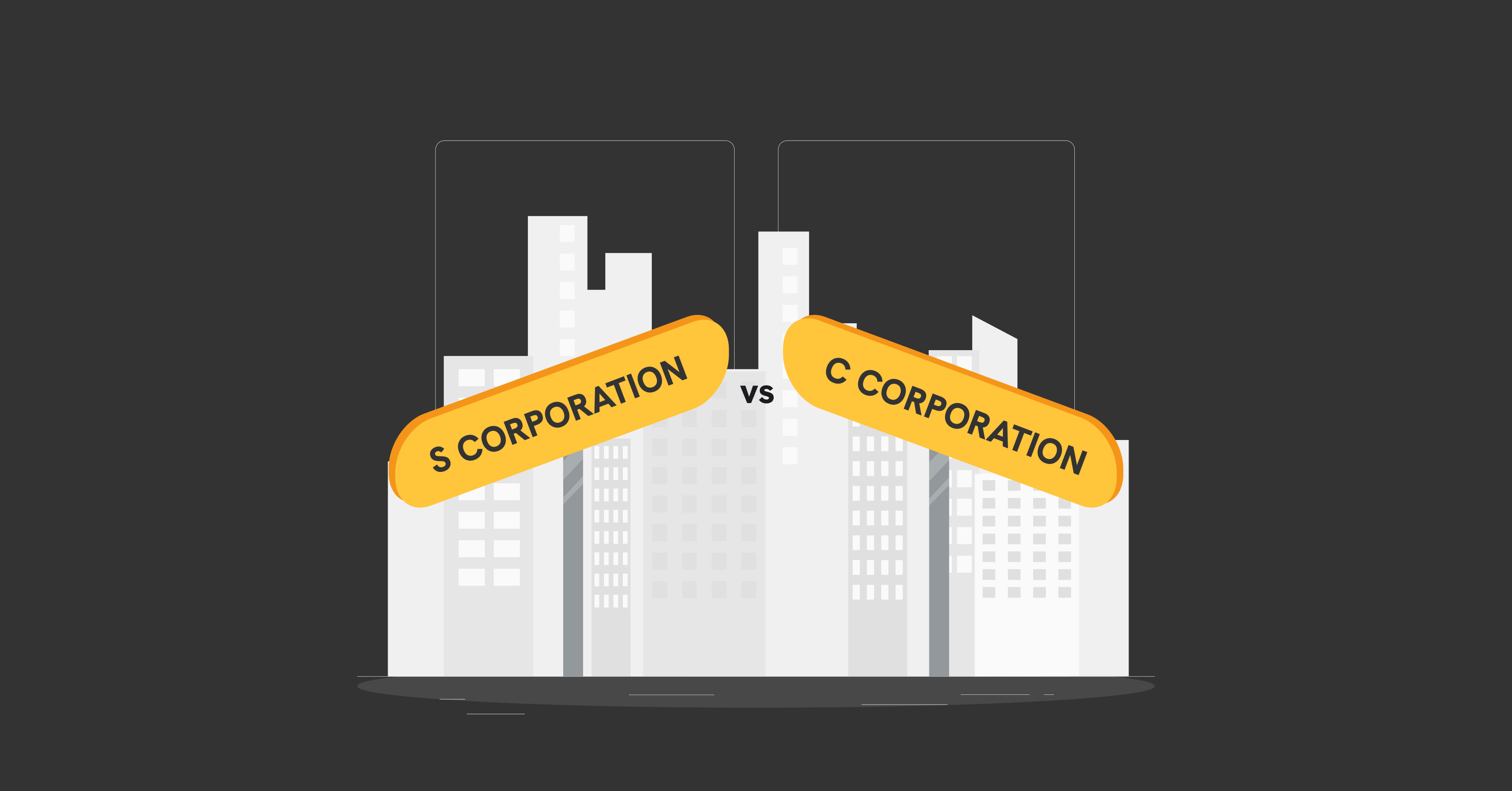If you are thinking about whether or not it’s better to form a C corp or an S corp for your business, understanding both the structure is crucial. While a C corporation may be best if you plan to go public one day, an S corporation can be better for small companies. Each type of corporation has its own benefits and drawbacks, as well as differences when it comes to corporate taxation. Each has different tax rules, ownership requirements, and legal obligations. Understanding these differences will help business owners choose the best path for growth and financial success.
This article takes a look at the differences between an S corp and a C corp so that you can decide which business structure is best for your company. Read on to learn more about C corporations vs. S corporations.
What Is a Corporation?
A corporation is a separate legal entity from its owners, providing protection from personal liability. This means that shareholders are not personally responsible for company debts. However, corporations must follow specific tax laws, reporting requirements, and legal formalities.
The two main types of corporations in the U.S. are S-Corporations and C-Corporations. Though they share some similarities, they operate under different tax structures and ownership rules.
What Is an S Corporation?
An S corporation is not a different type of business entity but rather a tax designation that a corporation can elect. Unlike a C corp, an S corp does not pay corporate taxes. Instead, profits and losses are passed through to shareholders, who report them on their personal tax returns. This eliminates double taxation and allows small business owners to benefit from pass-through taxation.
Key Features of an S Corporation
- Pass-through taxation, meaning no corporate-level tax.
- Limited liability protection for shareholders.
- Restricted to 100 shareholders, all of whom must be U.S. citizens or residents.
- Can only issue one class of stock, limiting investment flexibility.
- Requires corporate formalities, including regular board meetings and recordkeeping.
An S corp is ideal for small to mid-sized businesses that want to avoid double taxation while maintaining corporate liability protection.
See our S Corporation page for more information on C-corp tax forms, due dates, benefits, and more.
What Is a C Corporation?
A C corporation is the most common type of corporate entity. It is a separate business structure that is responsible for its own taxes and liabilities. Unlike an S corp, a C corp pays corporate taxes on its profits, and shareholders must pay taxes again when they receive dividends. This results in what is known as double taxation.
Key Features of a C Corporation
- Separate legal entity that protects owners from personal liability.
- Unlimited number of shareholders, including individuals, other corporations, and foreign investors.
- Pays corporate taxes at the federal and state level.
- Can issue multiple classes of stock (e.g., common and preferred stock).
- Follows strict corporate formalities, including annual meetings and recordkeeping.
A C corp is often the preferred choice for businesses that plan to expand, raise capital, or go public.
See our C Corporation page for more information on C-corp tax forms, due dates, benefits, and more.
Business Structure and Ownership
C Corporations:
- Can have unlimited shareholders, including foreign and corporate investors.
- Can issue multiple classes of stock (e.g., preferred and common).
- More attractive to venture capitalists and institutional investors.
S Corporations:
- Limited to 100 shareholders, all of whom must be U.S. citizens or residents.
- Can only issue one class of stock, which may limit investment opportunities.
- More suitable for family-owned businesses and small companies.
S-Corp and C-Corp: Key Differences
| Feature | S-Corporation (S-Corp) | C-Corporation (C-Corp) |
| Taxation | Pass-through taxation (profits taxed only at the individual level) | Subject to corporate tax and potential double taxation |
| Ownership | Limited to 100 U.S. citizens or residents | Unlimited shareholders, including foreign investors |
| Dividends | Profits passed through to owners and taxed once | Profits taxed twice—first at the corporate level, then as dividends |
| Stock Structure | Only one class of stock | Can issue multiple classes of stock |
| Corporate Formalities | Fewer requirements | More regulatory obligations |
| Filing Requirement | Must file Form 2553 with the IRS | No special election required |
Taxation: A Key Difference
Tax treatment is one of the biggest factors when deciding between an S-Corp and a C-Corp.
- S-Corporation Taxation
An S-Corp follows a pass-through taxation model. This means the business itself doesn’t pay federal taxes. Instead, profits and losses are passed directly to shareholders, who report them on their personal income tax returns. This structure avoids double taxation, making it a popular choice for small business owners. - C-Corporation Taxation
A C-Corp is subject to corporate income tax. The company pays taxes on its earnings, and if it distributes profits to shareholders as dividends, those payments are taxed again at the personal level. This results in double taxation, which can impact overall profits.
At X.TAX, we help businesses compare tax liabilities and determine whether an S-Corporation or a C-Corporation offers the best tax benefits.
Ownership and Shareholders
The ownership structure differs significantly between S-Corps and C-Corps.
- S-Corporation Ownership
- Can have a maximum of 100 shareholders.
- All shareholders must be U.S. citizens or residents.
- Cannot be owned by other corporations, LLCs, or partnerships.
- Limited to one class of stock.
- C-Corporation Ownership
- No restrictions on the number of shareholders.
- Can be owned by individuals, other corporations, or foreign investors.
- Can issue multiple classes of stock, making it more attractive to venture capitalists.
If attracting investors or expanding internationally is a priority, a C-Corporation may be the better choice. However, if keeping ownership simple and avoiding complex tax filings is more important, an S-Corp might be a better fit.
Corporate Formalities and Compliance
Both structures require adherence to legal and tax requirements, but C-Corporations have stricter rules.
- S-Corporation Corporate Formalities
- Must hold regular meetings and maintain corporate records.
- Must file annual reports but face fewer reporting obligations than C-Corps.
- Must file Form 2553 with the IRS to elect S-Corp status.
- C-Corporation Corporate Formalities
- Required to hold annual meetings for both directors and shareholders.
- Must adopt bylaws, issue stock, and maintain detailed corporate records.
- Must file annual reports and meet more regulatory obligations.
At X.TAX, we assist business owners in managing corporate compliance and record-keeping to avoid penalties and legal issues.
Dividends and Stock Structure
The way profits are distributed also varies between these two corporate structures.
- S-Corporation Dividends
- Profits are distributed directly to shareholders, avoiding corporate tax.
- Dividends are not taxed separately from personal income.
- C-Corporation Dividends
- Profits can be reinvested in the company or distributed as dividends.
- Dividends are taxed separately from corporate income, leading to potential double taxation.
- Can issue preferred stock to attract investors.
For businesses focused on attracting investors, a C-Corp allows for greater flexibility in raising capital. Meanwhile, for those looking to minimize tax burdens, an S-Corp provides a more tax-efficient structure.
Pros and Cons of an S Corporation
Advantages of an S Corporation:
- No Double Taxation – Profits are only taxed once, at the shareholder level.
- Limited Liability Protection – Owners are not personally liable for business debts.
- Easier to Sell or Transfer Ownership – Compared to LLCs and sole proprietorships.
Disadvantages of an S Corporation:
- Strict Shareholder Limits – No more than 100 shareholders.
- Limited Stock Options – Cannot issue multiple stock classes.
- Increased IRS Scrutiny – Must comply with strict IRS rules.
Pros and Cons of a C Corporation
Advantages of a C Corporation:
- Unlimited Shareholders – No restrictions on ownership.
- Easier to Raise Capital – Can issue multiple classes of stock.
- Lower Corporate Tax Rate – Ability to retain earnings at a lower tax rate.
Disadvantages of a C Corporation:
- Double Taxation – Profits are taxed at both the corporate and individual levels.
- More Compliance Requirements – Must file corporate tax returns and hold regular meetings.
- Higher Administrative Costs – More expensive to maintain.
Filing Form 1120-S: Reporting Income for S Corporations
Once a business elects S corporation (S corp) status, it must file Form 1120-S, the U.S. Income Tax Return for an S Corporation. This form is used to report the company’s income, deductions, credits, and other financial details to the IRS. Unlike a C corporation, which files Form 1120 and pays corporate taxes, an S corp does not pay federal income tax at the entity level. Instead, profits and losses pass through to shareholders, who report them on their personal tax returns.
Key Points About Filing Form 1120-S:
- Mandatory for All S Corporations – Any corporation that has elected S corp status must file Form 1120-S annually.
- Pass-Through Taxation – The S corporation itself does not pay corporate taxes; instead, income is reported on shareholders’ tax returns.
- Due Date – Form 1120-S is due by March 15 (or the 15th day of the third month after the end of the tax year).
- Schedule K-1 Reporting – Each shareholder receives a Schedule K-1, which details their share of the company’s income, deductions, and credits.
If an S corporation fails to file Form 1120-S on time, it may face IRS penalties, and shareholders could experience tax complications.
X.TAX, helps businesses accurately prepare and file Form 1120-S to ensure compliance with corporate taxation laws and IRS regulations.
____________________________________________________________________________________________________________________________________________
Recommended Reading: What is Form 1065 and Why Does It Matter?
____________________________________________________________________________________________________________________________________________
Which Business Structure Is Best for Your Tax Situation?
Choosing between an S corporation and a C corporation depends on your tax strategy and business goals:
- If you want pass-through taxation to avoid corporate income tax, an S corporation is a good option.
- If you plan to retain earnings within the company and scale your business, a C corporation offers more flexibility.
- If you prefer simpler taxation and less administrative burden, an S corp may be more manageable.
- If you want to raise capital and attract investors, a C corporation allows for multiple stock classes and unlimited shareholders.
Final Thoughts
Deciding between an S corporation and a C corporation comes down to your business goals, tax preferences, and long-term plans. If minimizing taxes and keeping things simple is your priority, an S corp might be the better fit. But if you’re looking to scale, attract investors, or go public, a C corp offers more flexibility.
No matter which path you choose, understanding the tax implications and compliance requirements is key to making an informed decision. And when it comes to filing your business taxes, whether it’s Form 1120-S for S corps or corporate tax returns for C corps, having the right support can make all the difference.
X.TAX, helps businesses in navigating these corporate tax filings with ease, so you can focus on growth while staying compliant.









